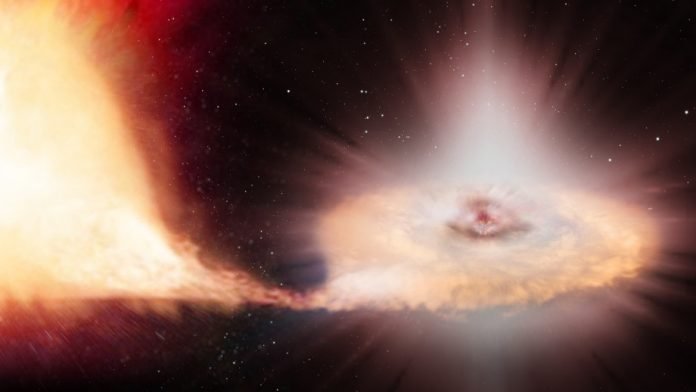
Things go pear-shaped when you split the atom, nuclear physicists have found.
Researchers from Australia and Japan found that when atoms split, in the process known as nuclear fission, the nuclei literally break into pieces the shape of pears – the fragments tend to form shapes that are rounded at one end and elongated into a neck at the other.
This observation that leads to the solution of an eighty-year old mystery about the nuclear fission process.
The finding, published in Nature, will help explain how the atoms that make up the world around us were formed in stars and could lead to better designed nuclear power plants.
“For a long time, people thought that fission was mostly influenced by quantum effects for spherical nuclei. But it was not really explaining what was observed,” said lead researcher Professor Cedric Simenel from the Research School of Physics at ANU.
“Our numerical simulations show that before the nuclei break they deform and form a neck, and break into pear-shaped fragments.”
Fission, the spontaneous breaking-apart of nuclei, is the process that releases energy in nuclear power, and is also a crucial step in the formation of elements in violent cosmic events such as exploding stars or colliding neutron stars.
But some details of how nuclei break apart, especially the relative size of the fragments, puzzled scientists. Large nuclei often do not split into two halves with an equal number of protons and neutrons, and the new finding helps explain why not.
It’s known that certain nuclei are especially stable – nuclear physicists call them magic. Examples include oxygen-16, calcium-48, tin-132 or lead-208, and the stability stems from having the right number of neutrons and protons to form a spherically shaped nucleus, which is a low-energy configuration.
These elements are the ones physicists expected might be commonly formed in fission. But often nuclei slightly larger were produced in preference to the magic ones: for example instead of tin-132, barium-144 is commonly formed.
The research team, led by Dr Guillaume Scamps at the University of Tsukuba in Japan, developed numerical simulations of fission – a process that takes of the order of a few tens of zeptoseconds (10-20 seconds) – and ran them on supercomputers at the National Computational Infrastructure at ANU, and in Japan.
The simulations showed that nuclei stretched to breaking point naturally formed not spherical fragments, but pear-shaped ones.
Like spherical shapes in magic nuclei, quantum effects can stabilise some nuclei in a pear shaped configuration – barium-144 is one of these. The pear shape forms with a different number of neutrons and protons to spherical nuclei, explaining the asymmetric splitting and formation of unexpected elements.
“It’s a breakthrough, we haven’t realised this before,” Professor Simenel said.
“It’s satisfying to find a new answer to an eighty-year old problem.”
Fission is a major part of the formation of elements, which occurs as stars collide or explode. In these extreme environments nuclei are constantly absorbing neutrons (known as the R-process). There is a limit to how heavy these nuclei can get as they become unstable and then fission.
Many elements found on earth are products of these fission events, so ultimately Professor Simenel’s work is helping explain the world around us.
“Our findings are a major step towards understanding the fission process to be able to simulate its influence on the abundance of the various atoms in the Universe,” Professor Simenel said.
“It’s opened the door to a whole program of new experiments.”



